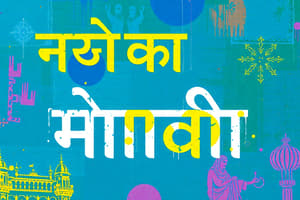Podcast
Questions and Answers
Hindi is the official language of which entity?
Hindi is the official language of which entity?
- The state of California
- The Union government of India (correct)
- The European Union
- The United Nations
From which language family does Hindi originate?
From which language family does Hindi originate?
- Austro-Asiatic
- Indo-European (correct)
- Dravidian
- Sino-Tibetan
Modern Standard Hindi developed from which dialect?
Modern Standard Hindi developed from which dialect?
- Bhojpuri
- Khariboli (correct)
- Maithili
- Awadhi
Which script is used to write Hindi?
Which script is used to write Hindi?
Which of the following is a characteristic of Hindi grammar?
Which of the following is a characteristic of Hindi grammar?
Which of these languages is closely related to Hindi?
Which of these languages is closely related to Hindi?
Which of the following states is part of the Hindi Belt?
Which of the following states is part of the Hindi Belt?
Which of the following historical periods contributed Persian, Arabic, and Turkic words to Hindi?
Which of the following historical periods contributed Persian, Arabic, and Turkic words to Hindi?
Words borrowed and modified from Sanskrit are known as what in Hindi?
Words borrowed and modified from Sanskrit are known as what in Hindi?
What is the word order of Hindi?
What is the word order of Hindi?
Which of the following is a major dialect of Hindi?
Which of the following is a major dialect of Hindi?
What is the composite language combining elements of Hindi and Urdu called?
What is the composite language combining elements of Hindi and Urdu called?
Which of the following is one of the official languages of the Union government of India?
Which of the following is one of the official languages of the Union government of India?
What is the Hindi-language film industry based in Mumbai commonly known as?
What is the Hindi-language film industry based in Mumbai commonly known as?
Which of these languages uses the Devanagari script?
Which of these languages uses the Devanagari script?
From which language did Hindi borrow words mostly during the Mughal period?
From which language did Hindi borrow words mostly during the Mughal period?
What is added to root words in Hindi to modify their meaning?
What is added to root words in Hindi to modify their meaning?
Flashcards
What is Devanagari?
What is Devanagari?
A script used to write several languages including Sanskrit, Marathi, and Nepali.
What are Tatsam words?
What are Tatsam words?
Words directly derived from Sanskrit and used in formal or literary Hindi.
What are Tadbhava words?
What are Tadbhava words?
Words borrowed and modified from Sanskrit, commonly used in everyday Hindi.
What are postpositions?
What are postpositions?
Signup and view all the flashcards
What is Subject-Object-Verb (SOV)?
What is Subject-Object-Verb (SOV)?
Signup and view all the flashcards
What is agglutination?
What is agglutination?
Signup and view all the flashcards
What is Khariboli?
What is Khariboli?
Signup and view all the flashcards
What is Hindustani?
What is Hindustani?
Signup and view all the flashcards
What role does Hindi play in Bollywood?
What role does Hindi play in Bollywood?
Signup and view all the flashcards
Why learn Hindi?
Why learn Hindi?
Signup and view all the flashcards
What is Hindi?
What is Hindi?
Signup and view all the flashcards
What are Prakrit languages?
What are Prakrit languages?
Signup and view all the flashcards
What is a lingua franca?
What is a lingua franca?
Signup and view all the flashcards
What is an abugida?
What is an abugida?
Signup and view all the flashcards
Main features of Hindi grammar
Main features of Hindi grammar
Signup and view all the flashcards
Languages that heavily influenced Hindi vocabulary
Languages that heavily influenced Hindi vocabulary
Signup and view all the flashcards
Study Notes
- Hindi is an Indo-Aryan language spoken primarily in India.
- It is the official language of the Union government of India and one of the 22 scheduled languages of the country.
- Hindi is often used as a lingua franca across the Hindi belt and, to some extent, in other parts of India.
Origin and History
- Hindi's origin can be traced back to the early forms of Prakrit languages.
- It evolved from the Apabhramsa languages, which were in turn derived from Prakrit.
- The modern standard Hindi developed from the Khariboli dialect of Delhi and surrounding regions.
- During the Delhi Sultanate and Mughal Empire, Hindi absorbed many Persian, Arabic, and Turkic words, contributing to the development of Hindustani.
- In the 19th century, efforts were made to standardize Hindi and promote its use in literature and education.
- Bharatendu Harishchandra played a pivotal role in modernizing Hindi prose and poetry.
- The Devanagari script was adopted as the standard writing system for Hindi.
Geographical Distribution
- Hindi is primarily spoken in the Hindi Belt of India, including states such as:
- Uttar Pradesh
- Madhya Pradesh
- Bihar
- Rajasthan
- Haryana
- Uttarakhand
- Chhattisgarh
- Himachal Pradesh
- Jharkhand
- Delhi
- Significant Hindi-speaking populations are also found in:
- Maharashtra
- West Bengal
- Punjab
- Gujarat
- Due to migration, Hindi speakers are present in various parts of India and the world.
- Hindi is also spoken in countries with large Indian diasporas, such as:
- Nepal
- Fiji
- Mauritius
- South Africa
- United States
- United Kingdom
Linguistic Features
- Hindi is an Indo-Aryan language, belonging to the Indo-European language family.
- It is closely related to other Indo-Aryan languages like:
- Urdu
- Punjabi
- Bengali
- Marathi
- Gujarati
- Hindi grammar is characterized by:
- Noun-verb agreement based on gender and number
- Postpositions instead of prepositions
- A relatively free word order
- A rich system of verb conjugations
- Hindi vocabulary is heavily influenced by:
- Sanskrit
- Persian
- Arabic
- English
Writing System
- Hindi is written in the Devanagari script.
- Devanagari is an abugida, where each consonant has an inherent vowel.
- Vowels can be written as independent letters or as diacritics modifying consonants.
- The script is written from left to right.
- Devanagari is also used for writing other languages like:
- Sanskrit
- Marathi
- Nepali
Vocabulary
- Hindi vocabulary is diverse, drawing from various sources.
- Sanskrit-derived words (Tatsam) form a significant part of formal and literary Hindi.
- Words borrowed and modified from Sanskrit (Tadbhava) are common in everyday speech.
- Persian and Arabic loanwords entered Hindi primarily during the Mughal period.
- English loanwords are increasingly common, especially in urban areas and technical fields.
Grammar
- Hindi grammar includes nouns, pronouns, verbs, adjectives, adverbs, and postpositions.
- Nouns are inflected for gender (masculine and feminine) and number (singular and plural).
- Pronouns distinguish between singular and plural and have different forms for different cases.
- Verbs are conjugated based on tense, aspect, mood, gender, and number.
- Postpositions follow nouns or pronouns and indicate relationships such as location, direction, and possession.
- Hindi uses a subject-object-verb (SOV) word order, but variations are common depending on emphasis and style.
- The language uses agglutination, where prefixes and suffixes are added to root words to modify their meaning.
Dialects
- Hindi exhibits regional variations in pronunciation, vocabulary, and grammar.
- Some major Hindi dialects include:
- Khariboli (the basis of standard Hindi)
- Braj Bhasha
- Awadhi
- Bagheli
- Bhojpuri (sometimes considered a separate language)
- Bundeli
- Chhattisgarhi
- Haryanvi
- Kanauji
- Marwari
- Nimadi
Relationship with Urdu
- Hindi and Urdu are mutually intelligible in their colloquial forms.
- They share a common grammatical structure and a significant portion of their core vocabulary.
- The primary difference lies in their script and higher-level vocabulary.
- Hindi uses Devanagari and draws heavily from Sanskrit, while Urdu uses Perso-Arabic script and borrows from Persian and Arabic.
- The composite language that combines elements of both Hindi and Urdu is known as Hindustani.
Status and Usage
- Hindi is the official language of the Union government of India.
- It is used in government administration, education, media, and commerce.
- Hindi is one of the 22 scheduled languages recognized by the Constitution of India.
- While English also serves as an official language, efforts are made to promote the use of Hindi.
- Hindi is the primary language of Bollywood, the Hindi-language film industry based in Mumbai.
- Hindi is widely used in television, radio, newspapers, and online media.
- The increasing reach of media and entertainment has contributed to the spread of Hindi across India and abroad.
Learning Hindi
- Learning Hindi can be valuable for:
- Understanding Indian culture
- Communicating with a large population in India
- Pursuing careers in fields such as translation, interpretation, teaching, and tourism
- Accessing Hindi literature, film, and music
- Resources for learning Hindi include:
- Language courses
- Textbooks
- Online resources
- Language exchange partners
- Immersion programs
Studying That Suits You
Use AI to generate personalized quizzes and flashcards to suit your learning preferences.
Description
Explore the origins and history of the Hindi language, an Indo-Aryan language and official language of India. Learn about its evolution from Prakrit and Apabhramsa languages, the influence of Hindustani, and standardization in the 19th century.




